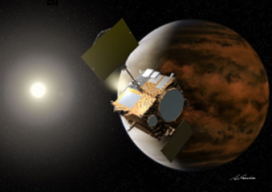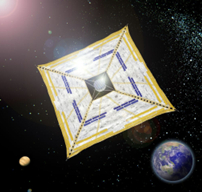|
Tokyo, Japan. July 22, 2010 - eSOL, a leading developer of real-time embedded software solutions,
announced today that its eCROS integrated software platform is being used
in the Japan Aerospace Exploration Agency's (JAXA) Venus orbiter "AKATSUKI"
(PLANET-C project) and the Small Solar Power Sail Demonstrator "IKAROS"
--- both launched on May 21. JAXA selected eSOL's eCROS in order to ensure
the reliability and quality of the spacecraft. eCROS also enabled the space
agency to develop the spacecraft at lower cost and in less time. eCROS
will be adopted in several satellites and orbiters planned to be launched
in the future.
AKATSUKI is equipped with five cameras that will take continuous images
of the Venusian atmosphere at various altitudes using different wavelengths
ranging from infrared to ultraviolet. The eT-Kernel real-time OS, which
is the core of eCROS, has been employed in the computer system that controls
four of the cameras and processes and records image data.
AKATSUKI's objective is to help scientists better understand Venusian meteorology
through continuous three-dimensional observation of the movement of the
planet's atmosphere by making full use of five cameras. Venus is called
Earth's twin planet because it has quite a few similarities, including
size, mass, and distance from the sun. However, the environment on Venus
is completely different from that on Earth. Venus is subjected to high
heat and high pressure, with temperatures of around 460 degrees Celsius
(860 degrees Fahrenheit) as a result of the greenhouse effect caused by
carbon dioxide, which comprises 96 percent of the atmosphere on Venus,
and atmospheric pressure about 90 times greater than that on Earth. Venus
is also covered by thick sulfuric acid clouds. By investigating Venusian
meteorological phenomena and comparing it to Earth, scientists expect to
find clues that may trace the birth of Earth and its recent climate change.
AKATSUKI is scheduled to arrive in Venusian orbit in December, after a
journey of six months, and to observe the planet for at least two years.
The eT-Kernel RTOS is also used in the IKAROS computer system to control
and deploy the spacecraft's solar sail, creating, in effect, the world's
first "space yacht." On July 9, JAXA confirmed that the square
sail membrane, measuring 20 meters diagonally, is successfully deployed
and is accelerating the speed of the spacecraft solely through pressure
from solar particles. IKAROS, the first spacecraft to demonstrate this
capability, will fly by Venus on its way to the far side of the sun. Thin-film
solar cells on the membrane are also confirmed to be producing electricity
for the spacecraft. According to JAXA, IKAROS is "the world's first
solar-powered sail craft employing both photon propulsion and thin film
solar power generation during its interplanetary cruise."
The computer systems on AKATSUKI and IKAROS are taking advantage of the
compact, lightweight "Space Cube architecture" for spacecraft
computer systems. eBinder, the eCROS integrated development environment,
was used to develop some of applications running on the computers.
"JAXA didn't have any doubt in adopting eT-Kernel in both AKATSUKI
and IKAROS because of the reliability, quality and performance the RTOS
demonstrated when it was employed in the SpaceWire demonstration Module
(SWIM) for Small Demonstration Satellite 1 launched last year," said
Makoto Suzuki, JAXA's chief scientist. "eCROS is a complete software
platform solution that encompasses a real-time OS, development tools, and
professional services so that we were able to highly streamline development."
"We are very excited that our eCROS platform has been adopted in AKATSUKI
and IKAROS, which are expected to greatly expand our understanding of the
solar system and space technology," said Nobuyuki Ueyama, the Executive
Vice President of eSOL. "We are committed to continue our development
of a superior software platform that will enable aerospace manufacturers
to build reliable, quality spacecraft at lower cost and in less time."
|



